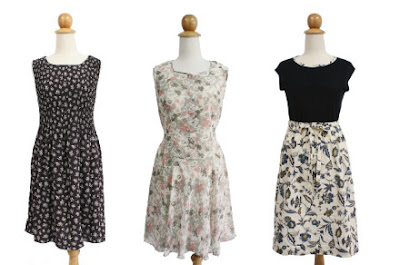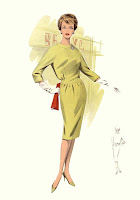Clothing of 1930s'
Fashion of the 1930s was directly influenced by the great Wall Street Crash of October 24, 1929 and subsequent Depression. The Autumn, 1930 Sears Catalogue admonished, “Thrift is the spirit of the day. Reckless spending is a thing of the past.” The beginning of the decade saw women sewing more. Clothing was mended and patched before being replaced.
A softer, more feminine style replaced the boyish, flapper look of the twenties. At the beginning of the decade, hemlines dropped dramatically to the ankle and remained there until the end of the thirties. Necklines were lowered while torsos were sensuously molded beneath squared shoulders. Skirts were also designed in great detail with moderately full skirts accentuating a small waist and minimizing the hips. Dress bodices were designed with inset pieces and yokes. Necklines received dramatic attention, often with wide scallop-edged or ruffled collars.
 The entertainment industry continued to exert a strong influence over fashion. Movies were one of the few escapes from the harsh reality of the Depression. Movie star endorsements of styles and accessories became common, especially with evening wear. A popular formal look was the empire-waisted gown, with ties at the back. The dress might boast butterfly or large, puffy sleeves. Hemlines fell at the ankle and trains added a further formal touch. Fabric flowers might be placed at the neckline, on one shoulder, or at the center waist or center neckline. Bows were another popular accent. The peplum made its debut in the late thirties evening wear.
The entertainment industry continued to exert a strong influence over fashion. Movies were one of the few escapes from the harsh reality of the Depression. Movie star endorsements of styles and accessories became common, especially with evening wear. A popular formal look was the empire-waisted gown, with ties at the back. The dress might boast butterfly or large, puffy sleeves. Hemlines fell at the ankle and trains added a further formal touch. Fabric flowers might be placed at the neckline, on one shoulder, or at the center waist or center neckline. Bows were another popular accent. The peplum made its debut in the late thirties evening wear.Fur of all kinds was worn extensively during this era, both during the day and at night. Fur capes, coats, stoles wraps, accessories and trimmings adorned women’s dresses. Pelts in demand were sable, mink, chinchilla, Persian lamb and silver fox.
The cloche hat was replaced by the beret which was worn at an angle. Pill boxes became popular along with brimmed hats. Popular hairstyles for women were still worn close to the head with the deep set, finger waves and later the waves loosened up.

A variety of shoe styles was available during this era. Rounded toes were seen with wide, thick heels. Pumps and flat shoes were available, and ankle strap styles with moderate heels also appeared. Slip-on styles, lace-up shoes and buckle shoes were all worn. Spectator or two-tone shoes appeared in the early thirties.

Handbags of the early thirties looked like those of the twenties. Beaded bags were abundant, as well as enameled mesh bags. During the later part of the decade, leather became very popular.
As far as men’s clothing, it was during this decade that promoting clothing for its ’snob appeal’ was begun. Clothing manufacturers have always known that if changes are continuously made to clothing so that it goes out of fashion quickly, more sales will be made as women rush out to refurbish their closets. This was not applied to men’s clothing though until the 1930s. Men also began to discard their undershirts supposedly because Clark Gable took off his shirt in a movie and only his bare chest was visible. Warm shirts in large plaids, and early in the 30s the single breasted jacket was the male look. Later in the decade, double breasted jackets became popular yet again and the front of the man’s jacket was higher.
This decade saw many improvements in mass production techniques, which meant a wider range of women now had access to well-made clothes. The advent of War in 1939 however stopped civilian access to clothing manufacturers for several years while the country focused on the war effort. On September 3, 1939 England and France declared war on Germany.
Picture Collections of 1930’s Fashions
These picture collections showing Fashion from the 1930’s are listed here, each section contains a selection of original 1930s fashion illustrations or pictures, depicting styles from the era.
1930’s icons
More 1930’s information






Credit :winifredandbance.com









 Barer bathing wear took on special significance as an expression of women’s newfound freedom. Swimsuits of the 1920s were either short taffeta shifts — favored by older women — or tight, sleeveless wool tank suits with built-in undershorts which stopped at mid-thigh. Women protected their bobbed hairdos by wearing bathing caps. Some women, especially in the most fashionable resorts, wore dramatic cover-ups over their suits. People became health-food, exercise and sun-worship oriented in a major fitness fad, triggered by all that flesh out in public view for the first time.
Barer bathing wear took on special significance as an expression of women’s newfound freedom. Swimsuits of the 1920s were either short taffeta shifts — favored by older women — or tight, sleeveless wool tank suits with built-in undershorts which stopped at mid-thigh. Women protected their bobbed hairdos by wearing bathing caps. Some women, especially in the most fashionable resorts, wore dramatic cover-ups over their suits. People became health-food, exercise and sun-worship oriented in a major fitness fad, triggered by all that flesh out in public view for the first time.





 In the early 1920s, hats had deep crowns and medium-to-large brims, but in 1923, brims began disappearing and hats became helmet-like. These hats, or cloches, were quite popular even though they were unattractive on anyone but the very young and the extremely pretty. Though in a spring, 1924 issue of Vogue would pose the question, “Is the cloche dead?” they were the latest fad for most of the 1920s, finally easing out of fashion around 1930.
In the early 1920s, hats had deep crowns and medium-to-large brims, but in 1923, brims began disappearing and hats became helmet-like. These hats, or cloches, were quite popular even though they were unattractive on anyone but the very young and the extremely pretty. Though in a spring, 1924 issue of Vogue would pose the question, “Is the cloche dead?” they were the latest fad for most of the 1920s, finally easing out of fashion around 1930. In summer, men sported broad brimmed Panama straw hats and in the fall and winter, English driving caps were popular for casual wear, while felt fedoras for everyday wear with suits and sport coats were frequently worn.
In summer, men sported broad brimmed Panama straw hats and in the fall and winter, English driving caps were popular for casual wear, while felt fedoras for everyday wear with suits and sport coats were frequently worn.
 Dresses were designed to move while dancing. Some had long trailing sashes, trains or asymmetric hemlines. Typically, women did not wear hats for evening, but instead wore fancy combs, scarves and bandeaux. For evening wear, Paris was the place and haute couture was hot. Paris was equated with high fashion, and even a scarf or a small accessory from that city was considered the ultimate in chic. Designers such as Molyneaux, Vionnet, Poiret, Lanvin, and Chanel reigned, and, late in the decade, an important newcomer appeared:
Dresses were designed to move while dancing. Some had long trailing sashes, trains or asymmetric hemlines. Typically, women did not wear hats for evening, but instead wore fancy combs, scarves and bandeaux. For evening wear, Paris was the place and haute couture was hot. Paris was equated with high fashion, and even a scarf or a small accessory from that city was considered the ultimate in chic. Designers such as Molyneaux, Vionnet, Poiret, Lanvin, and Chanel reigned, and, late in the decade, an important newcomer appeared: 































